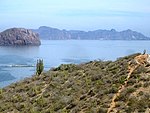
A | B | C | D | E | F | G | H | CH | I | J | K | L | M | N | O | P | Q | R | S | T | U | V | W | X | Y | Z | 0 | 1 | 2 | 3 | 4 | 5 | 6 | 7 | 8 | 9
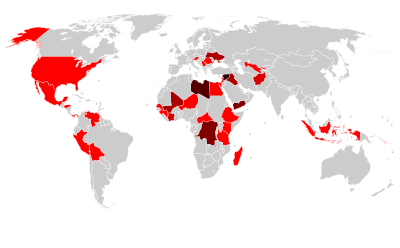
- Six or more sites
- Five sites
- Four sites
- Three sites
- Two sites
- One site
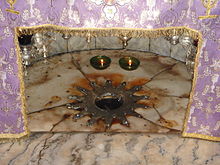
The List of World Heritage in Danger is compiled by the United Nations Educational, Scientific and Cultural Organization (UNESCO) through the World Heritage Committee according to Article 11.4 of the World Heritage Convention,[nb 1] which was established in 1972 to designate and manage World Heritage Sites. Entries in the list are threatened World Heritage Sites for the conservation of which major operations are required and for which "assistance has been requested".[1] The list is intended to increase international awareness of the threats and to encourage counteractive measures.[2] Threats to a site can be either proven imminent threats or potential dangers that could have adverse effects on a site.
In the case of natural sites, ascertained dangers include the serious decline in the population of an endangered or other valuable species or the deterioration of natural beauty or scientific value of a property caused by human activities such as logging, pollution, settlement, mining, agriculture and major public works. Ascertained dangers for cultural properties include serious deterioration of materials, structure, ornaments or architectural coherence and the loss of historical authenticity or cultural significance. Potential dangers for both cultural and natural sites include development projects, armed conflicts, insufficient management systems or changes in the legal protective status of the properties. In the case of cultural sites, gradual changes due to geology, climate or environment can also be potential dangers.[3]
Before a property is inscribed on the List of World Heritage in Danger, its condition is assessed and a potential programme for corrective measures is developed in cooperation with the State Party involved. The final decision about inscription is made by the committee. Financial support from the World Heritage Fund may be allocated by the committee for listed properties. The state of conservation is reviewed on a yearly basis, after which the committee may request additional measures, delete the property from the list if the threats have ceased or consider deletion from both the List of World Heritage in Danger and the World Heritage List.[3] Of the three former UNESCO World Heritage Sites, the Dresden Elbe Valley and the Liverpool Maritime Mercantile City were delisted after placement on the List of World Heritage in Danger while the Arabian Oryx Sanctuary was directly delisted.[4][5] Some sites have been designated as World Heritage Sites and World Heritage in Danger in the same year, such as the Church of the Nativity, traditionally considered to be the birthplace of Jesus.
In some cases, danger listing has sparked conservation efforts and prompted the release of funds, resulting in a positive development for sites such as the Galápagos Islands and Yellowstone National Park, both of which have subsequently been removed from the List of World Heritage in Danger. Despite this, the list itself and UNESCO's implementation of it have been the focus of criticism.[6][7] In particular, States Parties and other stakeholders of World Heritage Sites have questioned the authority of the Committee to declare a site in danger without their consent.[8] Until 1992, when UNESCO set a precedent by placing several sites on the danger list against their wishes, States Parties would have submitted a programme of corrective measures before a site could be listed.[9] Instead of being used as intended, the List of World Heritage in Danger is perceived by some states as a black list and according to Christina Cameron, Professor at the School of Architecture, Canada Research Chair on Built Heritage, University of Montreal, has been used as political tool to get the attention of States Parties.[10][11] The International Union for Conservation of Nature (IUCN) notes that UNESCO has referenced the List of World Heritage in Danger (without actually listing the site) in a number of cases where the threat could be easily addressed by the State Party.[12] The Union also argues that keeping a site listed as endangered over a long period is questionable and that other mechanisms for conservation should be sought in these cases.[13]
As of April 2024[update], there are 56 entries (16 natural, 40 cultural) on the List of World Heritage in Danger. Arranged by the UNESCO regions, 23 of the listed sites are located in the Arab States, 14 in Africa, 6 in Latin America and the Caribbean, 6 in Asia and the Pacific, and 7 in Europe and North America. The majority of the endangered natural sites (11) are located in Africa.[14][15] The list encompasses sites that have been identified as facing threats to their integrity, which could stem from natural disasters, armed conflict, neglect, pollution, unsustainable tourism, or other dangers. Among the sites, the impacts of armed conflict are evident in countries like Syria, with several sites including the Ancient City of Aleppo and the Ancient Villages of Northern Syria marked as endangered due to the Syrian Civil War. In Africa, the Democratic Republic of the Congo sees multiple listings due to threats like military conflict and environmental degradation affecting its national parks.[16]
Currently listed sites
- Table legend
- Name: as listed by the World Heritage Committee[17]
- Location: at city or provincial level and country name, with coordinates; column sorts by state[nb 2]
- Criteria: the site was listed under
- Area: in hectares and acres if provided by UNESCO
- Year (WHS): the year the site was inscribed on the World Heritage List
- Endangered: the year the site appeared on the List of World Heritage in Danger
- Reason: threats to the site which prompted UNESCO to list it as in danger
| Name | Image | Location | Criteria | Area ha (acre) |
Year (WHS) | Endangered | Reason | Refs |
|---|---|---|---|---|---|---|---|---|
| Abu Mena | 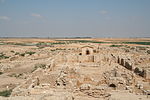
|
Abusir, 30°50′30″N 29°39′50″E / 30.84167°N 29.66389°E |
Cultural: (iv) |
182 (450) | 1979 | 2001– | Cave-ins in the area caused by the clay at the surface, which becomes semi-liquid when met with "excess water" | [18][19] [20] |
| Air and Ténéré Natural Reserves | 
|
Arlit Department, 18°17′N 8°0′E / 18.283°N 8.000°E |
Natural: (vii), (ix), (x) |
7,736,000 (19,120,000) | 1991 | 1992– | Jihadist insurgency and civil disturbance in the region as well as a reduction of wildlife population and degradation of the vegetation cover | [21][22] |
| Ancient City of Aleppo | 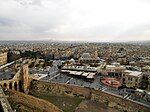
|
Aleppo Governorate, 36°14′N 37°10′E / 36.233°N 37.167°E |
Cultural: (iii), (iv) |
350 (860) | 1986 | 2013– | Syrian Civil War, currently held by the government. Bombings continue threatening the site. | [23] |
| Ancient City of Bosra | 
|
Daraa Governorate, 32°31′5″N 36°28′54″E / 32.51806°N 36.48167°E |
Cultural: (i), (iii), (vi) |
— | 1980 | 2013– | Syrian Civil War, held by the government. | [24] |
| Ancient City of Damascus | 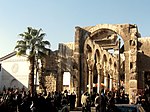
|
Damascus Governorate, 33°30′41″N 36°18′23″E / 33.51139°N 36.30639°E |
Cultural: (i), (ii), (iii), (iv), (vi) |
86 (210) | 1979 | 2013– | Syrian Civil War, rebel gunfire and mortar shelling, mainly from adjacent Jobar suburb endangers foundations. | [25] |
| Ancient Villages of Northern Syria | 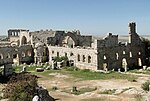
|
36°20′3″N 36°50′39″E / 36.33417°N 36.84417°E |
Cultural: (iii), (iv), (v) |
12,290 (30,400) | 2011 | 2013– | Syrian Civil War, some held by rebels. Reports of looting and demolitions by Islamist groups. | [26] |
| Archaeological Site of Cyrene | 
|
Jebel Akhdar, 32°49′30″N 21°51′30″E / 32.82500°N 21.85833°E |
Cultural: (ii), (iii), (vi) |
— | 1982 | 2016– | Libyan Civil War, presence of armed groups, already incurred and potential further damage. | [27][28] |
| Archaeological Site of Leptis Magna | 
|
Khoms, 32°38′18″N 14°17′35″E / 32.63833°N 14.29306°E |
Cultural: (i), (ii), (iii) |
— | 1982 | 2016– | Libyan Civil War, presence of armed groups, already incurred and potential further damage. | [28][29] |
| Archaeological Site of Sabratha | 
|
Sabratha, 32°48′19″N 12°29′6″E / 32.80528°N 12.48500°E |
Cultural: (iii) |
— | 1982 | 2016– | Libyan Civil War, presence of armed groups, already incurred and potential further damage. | [28][30] |
| Ashur (Qal'at Sherqat) | 
|
Salah ad Din, 35°27′24″N 43°15′45″E / 35.45667°N 43.26250°E |
Cultural: (iii), (iv) |
70 (170) | 2003 | 2003– | A planned reservoir that would have partially flooded the site was suspended in the wake of the Iraq War by the new administration; lack of adequate protection. | [31][32] |
| Chan Chan Archaeological Zone | 
|
La Libertad, 8°6′40″S 79°4′30″W / 8.11111°S 79.07500°W |
Cultural: (i), (iii) |
600 (1,500) | 1986 | 1986– | Natural erosion | [33][34] |
| City of Potosí | 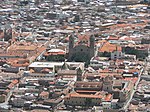
|
Potosí, |
Cultural: (ii), (iv), (vi) |
11,810 (29,200) | 1987 | 2014– | Continued mining has left the mountain porous and unstable, causing portions of the summit to collapse, also the target of future mining by the Bolivian Mining Corp. Recommendations to preserve the site have not been followed through. | [35] |
| Coro and its Port | 
|
Falcón, 11°25′N 69°40′W / 11.417°N 69.667°W |
Cultural: (iv), (v) |
107 (260) | 1993 | 2005– | Damage to a great number of structures due to heavy rain between November 2004 and February 2005 as well as the construction of a new monument, a beach walkway and an entrance gate to the city in the buffer zone which could have considerable impact on the value of the site | [36][37] |
| Crac des Chevaliers and Qal’at Salah El-Din | 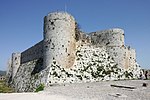
|
Homs and Latakia Governorates, 34°46′54″N 36°15′47″E / 34.78167°N 36.26306°E |
Cultural: (ii), (iv) |
9 (22) | 2006 | 2013– | Syrian Civil War, once held by Al-Nusra Front and other Islamist groups, reclaimed by Syrian Arab Army and Hezbollah fighters. Reports of damages and looting caused by Islamist groups was released by the government. | [38] |
| Cultural Landscape and Archaeological Remains of the Bamiyan Valley | Bamyan, 34°49′55″N 67°49′36″E / 34.83194°N 67.82667°E |
Cultural: (i), (ii), (iii), (iv), (vi) |
159 (390) | 2003 | 2003– | Fragile conservation state due to abandonment, military action and dynamite explosions; causing dangers such as risk of collapse of Buddha niches, further deterioration of cave murals, looting and illicit excavations. | [39][40] | |
| East Rennell | 
|
Rennell and Bellona Province, 11°40′59″S 160°10′59″E / 11.68306°S 160.18306°E |
Natural: (ix) |
37,000 (91,000) | 1998 | 2013– | Damage to the site due to logging and its effect on the local ecosystem | [41] |
| Everglades National Park | 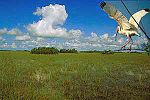
|
Florida, 25°19′N 80°56′W / 25.317°N 80.933°W |
Natural: (viii), (ix), (x) |
592,920 (1,465,100) | 1979 | 1993–2007, 2010– | Damage due to Hurricane Andrew and deterioration of water flow and quality due to agricultural and urban development (1993); continued degradation of the site resulting in a loss of marine habitat and decline in marine species (2010) | [42][43] [44] |
| Fortifications on the Caribbean Side of Panama: Portobelo-San Lorenzo | 
|
Colón Province, 9°33′14″N 79°39′21″W / 9.55389°N 79.65583°W |
Cultural: (i), (iv) |
— | 1980 | 2012– | Environmental factors, lack of maintenance and urban development | [45][46] |
| Garamba National Park | 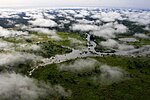
|
Orientale, 4°0′N 29°15′E / 4.000°N 29.250°E |
Natural: (vii), (x) |
500,000 (1,200,000) | 1980 | 1984–1992, 1996– | Reduction of northern white rhinoceros population (1984); poaching of two white rhinos, killing of three rangers and no plan for corrective measures by the authorities (1996) | [47][48] [49] |
| Hatra | 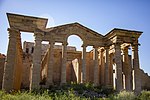
|
Nineveh Governorate, 35°35′17″N 42°43′6″E / 35.58806°N 42.71833°E |
Cultural: (ii), (iii), (iv), (vi) |
324 (800) | 1985 | 2015– | Damage inflicted to the property by the Islamic State (IS). | [50][51] |
| Hebron | 
|
Hebron Governorate, 31°31′27″N 35°6′32″E / 31.52417°N 35.10889°E |
Cultural: (ii), (iv), (vi) |
20.6 (51) | 2017 | 2017– | [52] | |
| Historic Centre of Odesa | 
|
Odesa, 46°29′11.22″N 30°44′29.81″E / 46.4864500°N 30.7416139°E |
Cultural: (ii), (iv) |
— | 2023 | 2023– | Russo-Ukrainian War | [53][54] |
| Kyiv: Saint-Sophia Cathedral and Related Monastic Buildings, Kyiv Pechersk Lavra | 
|
Kyiv, |
Cultural: (i), (ii), (iii), (iv) |
— | 1990 | 2023– | Russo-Ukrainian War | [55] |
| L'viv – the Ensemble of the Historic Centre | 
|
Lviv, |
Cultural: (ii), (v) |
— | 1998 | 2023– | Russo-Ukrainian War | [55] |
| Historic Centre of Shakhrisyabz | 
|
Qashqadaryo Region, 39°3′0″N 66°50′0″E / 39.05000°N 66.83333°E |
Cultural: (iii), (iv) |
240 (590) | 2000 | 2016– | Destruction of buildings in its medieval neighbourhoods and continuing urban development. | [56][57] |
| Historic Centre of Vienna | 
|
Vienna, 48°12′N 16°22′E / 48.200°N 16.367°E |
Cultural: (ii), (iv), (vi) |
371 (920) | 2001 | 2017– | New high-rise projects | [58] |
| Historic Town of Zabīd | Al Hudaydah, 14°12′N 43°19′E / 14.200°N 43.317°E |
Cultural: (ii), (iv), (vi) |
— | 1993 | 2000– | Deteriorating state of historic buildings, inscribed on request of the State Party | [59][60] | |
| Islands and Protected Areas of the Gulf of California | Baja California, Baja California Sur, Sonora, Sinaloa and Nayarit, 27°38′N 112°33′W / 27.633°N 112.550°W |
Natural: (vii), (ix), (x) |
688,558 (1,701,460) | 2005 | 2019– | Imminent extinction of the vaquita, an endemic porpoise in the gulf | [61][62] | |
| Kahuzi-Biega National Park | South Kivu and Maniema, 2°30′S 28°45′E / 2.500°S 28.750°E |
Natural: (x) |
600,000 (1,500,000) | 1980 | 1997– | Deforestation, hunting as well as war and civil strife | [63][64] | |
| Lake Turkana National Parks | 3°3′8″N 36°30′13″E / 3.05222°N 36.50361°E |
Natural: (viii), (x) |
161,485 (399,040) | 1997 | 2018– | Impact of Ethiopia's Gilgel Gibe III Dam on the lake's flow and ecosystem | [65][66] | |
| Landmarks of Ancient Kingdom of Saba | Marib, 15°25′36.76″N 45°20′6.82″E / 15.4268778°N 45.3352278°E |
Cultural: (iii), (iv) |
375.29 (927.4) | 2023 | 2023– | Threats of destruction caused by the Yemeni Civil War. | [67][68] | |
| Manovo-Gounda St Floris National Park | Bamingui-Bangoran, 9°0′N 21°30′E / 9.000°N 21.500°E |
Natural: (ix), (x) |
1,740,000 (4,300,000) | 1988 | 1997– | Illegal grazing and poaching, deteriorating security situation | [69][70] | |
| Minaret and Archaeological Remains of Jam | 
|
Ghōr, 34°23′48″N 64°30′58″E / 34.39667°N 64.51611°E |
Cultural: (ii), (iii), (iv) |
70 (170) | 2002 | 2002– | Lack of legal protection, lack of protection measure or management plan, poor condition of the site | [71][72] |
| Medieval Monuments in Kosovo | 
|
42°39′40″N 20°15′56″E / 42.66111°N 20.26556°E |
Cultural: (ii), (iii), (iv) |
2.88 (7.1) | 2004 | 2006– | March Pogrom, lack of legal protection and management; political instability and insecurity. | [73][74] |
| Mount Nimba Strict Nature Reserve | 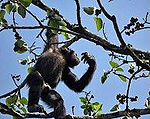
|
Lola Prefecture, 7°36′N 8°23′W / 7.600°N 8.383°W |
Natural: (ix), (x) |
18,000 (44,000) | 1981 | 1992– | Iron ore mining concession on part of the World Heritage Site and influx of large number of refugees on the Guinean part of the site | [75][76] |
| Nan Madol: Ceremonial Centre of Eastern Micronesia | 
|
Temwen Island, 6°50′23″N 158°19′51″E / 6.83972°N 158.33083°E |
Cultural: (i), (iii), (iv), (vi) |
76.7 (190) | 2016 | 2016– | Continuing siltation of waterways contributing to overgrowth and undermining existing structures. | [77][78] |
| Niokolo-Koba National Park | 
|
Tambacounda Region and Kédougou Region, 13°0′N 12°40′W / 13.000°N 12.667°W |
Natural: (x) |
Zdroj:https://en.wikipedia.org?pojem=World_Heritage_in_Danger



